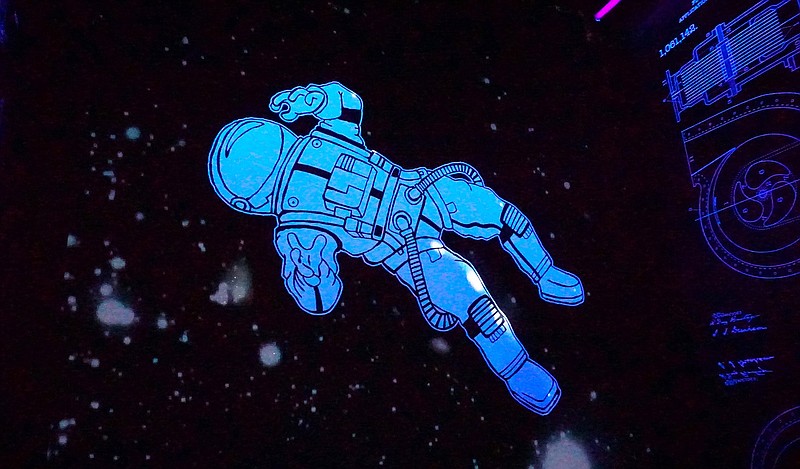Doctors have poked and prodded NASA astronauts for years, and the astronauts, as government employees, have largely acceded to their roles as test animals in studying how an alien environment - outer space - affects the human body.
But professional astronauts have historically been a small slice of humanity. Initially, they were chosen from the ranks of military test pilots who were white, physically fit men. Later, as NASA broadened its criteria, it still chose only astronauts who passed their physical thresholds.
But that could be changing as private spaceflight opens space to a more diverse cross section of humanity.
For scientists, the change will create a bonanza of new data on how the human body adapts to space.
The Inspiration4 mission, which launched and landed last week, shows how medical researchers can benefit from the new commercial space travel. The crew of four, none of whom are professional astronauts, were to spend some time in orbit helping to advance medical research.
One of the passengers, Hayley Arceneaux, exemplifies those possibilities. At 29, she is younger than most space travelers, a cancer survivor and was the first person in space with a prosthesis - metal rods that were implanted after a tumor was removed from her left leg.
"We're going to learn some things that are very fundamental," said Dorit Donoviel, executive director of the Translational Research Institute for Space Health, or TRISH, at the Baylor College of Medicine in Houston, which was coordinating research during the Inspiration4 flight.
Research to date has revealed that fluids shift upward in the body in the absence of gravity - swollen heads, shrunken legs. The lack of gravity also weakens bones. Not only does radiation in space slam into DNA, creating mutations, but the unusual conditions of weightlessness cause some genes to turn on and others to turn off. The biological repercussions of these alterations are not yet understood.
The crew aboard Inspiration4 were to take 10 tests originally designed to gauge the mental performance of NASA astronauts each day. The tests take about 20 minutes to complete.
"It needed to be brief, because astronauts kind of hate doing these things," said Dr. Mathias Basner, a professor of psychiatry at the University of Pennsylvania who is lead investigator for that experiment.
But in a dangerous environment like space, small errors can lead to catastrophe.
"So we need our astronauts to perform at their best all the time," Basner said. "Now, the problem is that humans are particularly bad at self-assessing their performance capability, especially in chronic exposure situations. If you sit in the same environment all the time, you think you'll be fine, but you're actually not."
One test is simply a square that appears on a screen, and one has to tap on it. The square changes position and progressively becomes smaller. That measures reaction speed and eye-hand coordination.
Another measures what is known as psychomotor vigilance. First, the subject stares at a box on the screen. A stopwatch suddenly pops up within the box, counting the milliseconds until the subject presses a button. "Which is extremely sensitive to sleep deprivation," Basner said.
Yet another test gauges a person's ability to identify emotions in other people.
The test displays 20 faces showing a variety of emotions - happy, sad, angry, fearful or expressing no emotion. In a so-called bed rest study - lying down for extended periods of time mimics many of the physical effects of weightlessness in space - subjects were able to still correctly identify most of the emotions. But they took longer to identify them, and their responses skewed to more negative expressions.
Mark J. Shelhamer, a professor at Johns Hopkins Medicine, is gathering data on how spaceflight affects the vestibular system - the parts of the human body, particularly the inner ear, that maintain balance.
His research consists of two parts, conducted before launch and after return to Earth. One was to measure the crew members' postures. "It's just what it sounds like," Shelhamer said. "It's the ability to stand up. And the ability to stand up is not only based on muscle strength, but it's based on coordination."
The Inspiration4 crew members were to hold a Windows tablet to their chests, put their feet together and close their eyes. Accelerators in the tablet measure how much they sway as they stand.
"That's not so hard to do on Earth," Shelhamer said. "But it can be challenging after having spent some time in space."
Shelhamer also devised a test using the tablet to study whether weightlessness causes eyes to become misaligned. That could give hints of how the brain might become confused, disrupting the sense of balance.
What researchers want to learn is how to predict who becomes sick in space. Surprisingly, there is no correlation between who experiences motion sickness on Earth - on a boat rocking back and forth, during a long car trip, even short episodes of floating during parabolic plane flights - and those who become sick in orbit.
TRISH, the organization Donoviel leads, has built a database to store the study results that not only protects the privacy of private space travelers in accordance with requirements of HIPAA, the Health Insurance Portability and Accountability Act, but will also allow researchers to compare data from different studies for one individual.
For instance, Shelhamer might want to know whether an individual whose ability to stand straight without swaying declined after a trip to space also encountered cognitive slowdowns while taking Basner's tests. That is often not possible with how NASA reports data collected on its astronauts, he said.
In addition, the Inspiration4 crew members wore Apple Watches that measured their heart beats and oxygen levels. They also tested out ultrasound devices that tracked how water in their bodies shifts upward while they float in orbit. That could help solve the puzzle of the squashing of eyeballs and resulting shift in vision experienced by some astronauts.
This article originally appeared in The New York Times.

